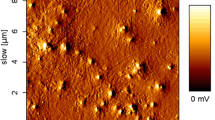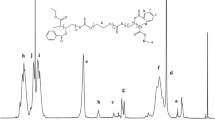Abstract
Drug encapsulation into amphiphilic block copolymer micelles aims to increase drug solubility and minimize drug degradation upon administration, avoid undesirable side effects and ameliorate drug bioavailability. Drug encapsulation methodologies including thin-film hydration method and organic cosolvent method are described in this chapter. Often, it is desirable to determine the most efficient solubilization protocol leading to functional drug delivery nanovehicles in each case. The encapsulation of curcumin into PEO-b-PPO-b-PEO (Pluronic F-127) polymeric micelles through thin-film hydration method presents the most promising results. Indomethacin can be loaded successfully into the hydrophobic cores of PEO-b-PCL amphiphilic block copolymer micelles following both encapsulation protocols.
Access this chapter
Tax calculation will be finalised at checkout
Purchases are for personal use only
Similar content being viewed by others
References
Cabral H, Miyata K, Osada K, Kataoka K (2018) Block copolymer micelles in nanomedicine applications. Chem Rev 118(14):6844–6892. https://doi.org/10.1021/acs.chemrev.8b00199
Torchilin VP (2005) Block copolymer micelles as a solution for drug delivery problems. Expert Opin Ther Pat 15(1):63–75. https://doi.org/10.1517/13543776.15.1.63
Fairbanks BD, Gunatillake PA, Meagher L (2015) Biomedical applications of polymers derived by reversible addition - fragmentation chain-transfer (RAFT). Adv Drug Deliv Rev 91:141–152. https://doi.org/10.1016/j.addr.2015.05.016
Basak R, Bandyopadhyay R (2013) Encapsulation of hydrophobic drugs in Pluronic F127 micelles: effects of drug hydrophobicity, solution temperature, and pH. Langmuir 29(13):4350–4356. https://doi.org/10.1021/la304836e
Chiappetta DA, Sosnik A (2007) Poly (ethylene oxide)–poly (propylene oxide) block copolymer micelles as drug delivery agents: improved hydrosolubility, stability and bioavailability of drugs. Eur J Pharm Biopharm 66(3):303–317. https://doi.org/10.1016/j.ejpb.2007.03.022
Sahu A, Kasoju N, Goswami P, Bora U (2011) Encapsulation of curcumin in Pluronic block copolymer micelles for drug delivery applications. J Biomater Appl 25(6):619–639. https://doi.org/10.1177/0885328209357110
Bodratti AM, Alexandridis P (2018) Formulation of poloxamers for drug delivery. J Funct Biomater 9(1):11. https://doi.org/10.3390/jfb9010011
Ma Z, Haddadi A, Molavi O, Lavasanifar A, Lai R, Samuel J (2008) Micelles of poly(ethylene oxide)-b-poly(epsilon-caprolactone) as vehicles for the solubilization, stabilization, and controlled delivery of curcumin. J Biomed Mater Res A 86(2):300–310. https://doi.org/10.1002/jbm.a.31584
Gou M, Men K, Shi H, **ang M, Zhang J, Song J, Long J, Wan Y, Luo F, Zhao X, Qian Z (2011) Curcumin-loaded biodegradable polymeric micelles for colon cancer therapy in vitro and in vivo. Nanoscale 3(4):1558–1567. https://doi.org/10.1039/c0nr00758g
Meier MAR, Aerts SNH, Staal BBP, Rasa M, Schubert US (2005) PEO-b-PCL block copolymers: synthesis, detailed characterization, and selected micellar drug encapsulation behavior. Macromol Rapid Commun 26(24):1918–1924. https://doi.org/10.1002/marc.200500591
Bisht S, Feldmann G, Soni S, Ravi R, Karikar C, Maitra A, Maitra A (2007) Polymeric nanoparticle-encapsulated curcumin (“nanocurcumin”): a novel strategy for human cancer therapy. J Nanobiotechnol 5(1):3. https://doi.org/10.1186/1477-3155-5-3
Sharma RA, Steward WP, Gescher AJ (2007) Pharmacokinetics and pharmacodynamics of curcumin. In: The molecular targets and therapeutic uses of curcumin in health and disease. Springer, New York, NY, pp 453–470. https://doi.org/10.1007/978-0-387-46401-5_20
Liu M, Teng CP, Win KY, Chen Y, Zhang X, Yang DP, Li Z, Ye E (2019) Polymeric encapsulation of turmeric extract for bioimaging and antimicrobial applications. Macromol Rapid Commun 40(5):e1800216. https://doi.org/10.1002/marc.201800216
Nalamachu S, Wortmann R (2014) Role of indomethacin in acute pain and inflammation management: a review of the literature. Postgrad Med 126(4):92–97. https://doi.org/10.3810/pgm.2014.07.2787
Dupeyron D, Kawakami M, Ferreira AM, Caceres-Velez PR, Rieumont J, Azevedo RB, Carvalho JC (2013) Design of indomethacin-loaded nanoparticles: effect of polymer matrix and surfactant. Int J Nanomedicine 8:3467–3477. https://doi.org/10.2147/IJN.S47621
Khadka P, Ro J, Kim H, Kim I, Kim JT, Kim H, Cho JM, Yun G, Lee J (2014) Pharmaceutical particle technologies: an approach to improve drug solubility, dissolution and bioavailability. Asian J Pharm Sci 9(6):304–316. https://doi.org/10.1016/j.ajps.2014.05.005
Wei Z, Hao J, Yuan S, Li Y, Juan W, Sha X, Fang X (2009) Paclitaxel-loaded Pluronic P123/F127 mixed polymeric micelles: formulation, optimization and in vitro characterization. Int J Pharm 376(1–2):176–185. https://doi.org/10.1016/j.ijpharm.2009.04.030
Dabholkar RD, Sawant RM, Mongayt DA, Devarajan PV, Torchilin VP (2006) Polyethylene glycol-phosphatidylethanolamine conjugate (PEG-PE)-based mixed micelles: some properties, loading with paclitaxel, and modulation of P-glycoprotein-mediated efflux. Int J Pharm 315(1–2):148–157. https://doi.org/10.1016/j.ijpharm.2006.02.018
Kabanov AV, Batrakova EV, Alakhov VY (2002) Pluronic® block copolymers as novel polymer therapeutics for drug and gene delivery. J Control Release 82(2–3):189–212. https://doi.org/10.1016/S0168-3659(02)00009-3
Chen X, Zou LQ, Niu J, Liu W, Peng SF, Liu CM (2015) The stability, sustained release and cellular antioxidant activity of curcumin nanoliposomes. Molecules 20(8):14293–14311. https://doi.org/10.3390/molecules200814293
Del Arco M, Cebadera E, Gutierrez S, Martin C, Montero M, Rives V, Rocha J, Sevilla M (2004) Mg, Al layered double hydroxides with intercalated indomethacin: synthesis, characterization, and pharmacological study. J Pharm Sci 93(6):1649–1658. https://doi.org/10.1002/jps.20054
Acknowledgments
This work has been co-financed by the European Union and Greek national funds through the program “Support for Researchers with Emphasis on Young Researchers” (call code: EDBM34, ΚΕ 14995) and under the research title “Preparation and study of innovative forms of administration of pharmaceutical molecules targeting at improved pharmacological properties.”
Author information
Authors and Affiliations
Corresponding author
Editor information
Editors and Affiliations
Rights and permissions
Copyright information
© 2021 Springer Science+Business Media, LLC, part of Springer Nature
About this protocol
Cite this protocol
Chroni, A., Chrysostomou, V., Skandalis, A., Pispas, S. (2021). Drug Delivery: Hydrophobic Drug Encapsulation into Amphiphilic Block Copolymer Micelles. In: Mavromoustakos, T., Tzakos, A.G., Durdagi, S. (eds) Supramolecules in Drug Discovery and Drug Delivery. Methods in Molecular Biology, vol 2207. Humana, New York, NY. https://doi.org/10.1007/978-1-0716-0920-0_6
Download citation
DOI: https://doi.org/10.1007/978-1-0716-0920-0_6
Published:
Publisher Name: Humana, New York, NY
Print ISBN: 978-1-0716-0919-4
Online ISBN: 978-1-0716-0920-0
eBook Packages: Springer Protocols




